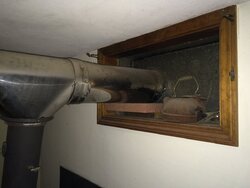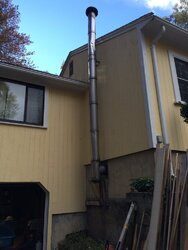There is but when I install the new flue I was going to have my mason block it up so I can use a thimble and route it through the wall properly. I don't have to block it entirely but what do you suggest? I'll take a few photos of the whole system so everyone can see what I'm working with.isnt there space through the old window?
Running in Reverse
- Thread starter bigblulbz
- Start date
-
Active since 1995, Hearth.com is THE place on the internet for free information and advice about wood stoves, pellet stoves and other energy saving equipment.
We strive to provide opinions, articles, discussions and history related to Hearth Products and in a more general sense, energy issues.
We promote the EFFICIENT, RESPONSIBLE, CLEAN and SAFE use of all fuels, whether renewable or fossil.
You are using an out of date browser. It may not display this or other websites correctly.
You should upgrade or use an alternative browser.
You should upgrade or use an alternative browser.
- Status
- Not open for further replies.
When I was in the propane business, a burner requiring fresh air like in your case would be 3 inch PVC through the wall or closed off window as in your case. An elbow outside pointing down with insect screen. An elbow inside pointing up. That way warmer inside air won't drop down the pipe. Warmer outside air in summer may rise into basement, so blocking it for the summer helps prevent humid air entering and condensing inside. It will only draw what it needs during winter. It was called an elephant trunk by some, and customers would feel the cold air rushing in when the burner was on and plug it with rags. They didn't realize the burner and chimney draft will pull from every crack in the house to get air anyway. So I explained it was better to have cold air feed the burner directly from the intake close to it than create drafts through the house from anywhere it can. Sometimes the house intake becomes a unused fireplace that smells all the time that people think is normal... Every exhaust fan including bath, range hood, dryer, central vac needs a source of air. It alleviates a lot of problems.
If you don't like the idea of a cold air intake, a metal box can be made with HVAC duct work. Run the cold air inlet pipe into it along with holes on the sides to become a mixing box for inside and outside air. Stubborn customers didn't seem to have a problem with that. And a couple holes on top of the box they couldn't plug.
Your stove now gets air that cools and drops down the stairs and moves toward it. The intake helps prevent it from burning your indoor heated air. You want the air to circulate, not go up the chimney.
The best case scenario for stairways is having the stove on the opposite side of the building away from stairs. 2 vents (with auto closing fire dampers) through the floor above stove allows heated air to rise. (sometimes with small duct booster fans as well) As it cools, it must traverse the house to drop back down the stairs to be heated again. If you only have the single stairway rising up, you don't get the circulation through the house with a good return system. The cold air drops like a waterfall down the steps and back toward stove to be reheated. Goldilocks and Honey Bear for factory built homes have an air intake built into the stove for connection to outside making them more efficient Fisher models.
If you don't like the idea of a cold air intake, a metal box can be made with HVAC duct work. Run the cold air inlet pipe into it along with holes on the sides to become a mixing box for inside and outside air. Stubborn customers didn't seem to have a problem with that. And a couple holes on top of the box they couldn't plug.

Your stove now gets air that cools and drops down the stairs and moves toward it. The intake helps prevent it from burning your indoor heated air. You want the air to circulate, not go up the chimney.
The best case scenario for stairways is having the stove on the opposite side of the building away from stairs. 2 vents (with auto closing fire dampers) through the floor above stove allows heated air to rise. (sometimes with small duct booster fans as well) As it cools, it must traverse the house to drop back down the stairs to be heated again. If you only have the single stairway rising up, you don't get the circulation through the house with a good return system. The cold air drops like a waterfall down the steps and back toward stove to be reheated. Goldilocks and Honey Bear for factory built homes have an air intake built into the stove for connection to outside making them more efficient Fisher models.
That's a lot to take in. Will review again in the morning.When I was in the propane business, a burner requiring fresh air like in your case would be 3 inch PVC through the wall or closed off window as in your case. An elbow outside pointing down with insect screen. An elbow inside pointing up. That way warmer inside air won't drop down the pipe. Warmer outside air in summer may rise into basement, so blocking it for the summer helps prevent humid air entering and condensing inside. It will only draw what it needs during winter. It was called an elephant trunk by some, and customers would feel the cold air rushing in when the burner was on and plug it with rags. They didn't realize the burner and chimney draft will pull from every crack in the house to get air anyway. So I explained it was better to have cold air feed the burner directly from the intake close to it than create drafts through the house from anywhere it can. Sometimes the house intake becomes a unused fireplace that smells all the time that people think is normal... Every exhaust fan including bath, range hood, dryer, central vac needs a source of air. It alleviates a lot of problems.
If you don't like the idea of a cold air intake, a metal box can be made with HVAC duct work. Run the cold air inlet pipe into it along with holes on the sides to become a mixing box for inside and outside air. Stubborn customers didn't seem to have a problem with that. And a couple holes on top of the box they couldn't plug.
Your stove now gets air that cools and drops down the stairs and moves toward it. The intake helps prevent it from burning your indoor heated air. You want the air to circulate, not go up the chimney.
The best case scenario for stairways is having the stove on the opposite side of the building away from stairs. 2 vents (with auto closing fire dampers) through the floor above stove allows heated air to rise. (sometimes with small duct booster fans as well) As it cools, it must traverse the house to drop back down the stairs to be heated again. If you only have the single stairway rising up, you don't get the circulation through the house with a good return system. The cold air drops like a waterfall down the steps and back toward stove to be reheated. Goldilocks and Honey Bear for factory built homes have an air intake built into the stove for connection to outside making them more efficient Fisher models.
When I was in the propane business, a burner requiring fresh air like in your case would be 3 inch PVC through the wall or closed off window as in your case. An elbow outside pointing down with insect screen. An elbow inside pointing up. That way warmer inside air won't drop down the pipe. Warmer outside air in summer may rise into basement, so blocking it for the summer helps prevent humid air entering and condensing inside. It will only draw what it needs during winter. It was called an elephant trunk by some, and customers would feel the cold air rushing in when the burner was on and plug it with rags. They didn't realize the burner and chimney draft will pull from every crack in the house to get air anyway. So I explained it was better to have cold air feed the burner directly from the intake close to it than create drafts through the house from anywhere it can. Sometimes the house intake becomes a unused fireplace that smells all the time that people think is normal... Every exhaust fan including bath, range hood, dryer, central vac needs a source of air. It alleviates a lot of problems.
If you don't like the idea of a cold air intake, a metal box can be made with HVAC duct work. Run the cold air inlet pipe into it along with holes on the sides to become a mixing box for inside and outside air. Stubborn customers didn't seem to have a problem with that. And a couple holes on top of the box they couldn't plug.
Your stove now gets air that cools and drops down the stairs and moves toward it. The intake helps prevent it from burning your indoor heated air. You want the air to circulate, not go up the chimney.
The best case scenario for stairways is having the stove on the opposite side of the building away from stairs. 2 vents (with auto closing fire dampers) through the floor above stove allows heated air to rise. (sometimes with small duct booster fans as well) As it cools, it must traverse the house to drop back down the stairs to be heated again. If you only have the single stairway rising up, you don't get the circulation through the house with a good return system. The cold air drops like a waterfall down the steps and back toward stove to be reheated. Goldilocks and Honey Bear for factory built homes have an air intake built into the stove for connection to outside making them more efficient Fisher models.
Finally got some photos.

- Status
- Not open for further replies.
Similar threads
- Replies
- 33
- Views
- 2K
- Replies
- 1
- Views
- 848
- Replies
- 11
- Views
- 676
- Replies
- 68
- Views
- 2K


